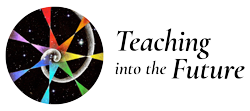In 2008 I began to explore the balance between teacher presentation and student participation in subject material in order to leave room for what I call the unfinished lesson. My lenses were Steiner’s educational philosophy, contemporary educators, theorists and futurists.My experience as a teacher showed me the longings of both teachers and students for a meaningful learning experience.
“Vocation is the place where your deep gladness and the world’s deep hunger meet”
(F. Buechner, 1993, Wishful Thinking, p. 119).
Steiner, founder of Waldorf Education, said that teachers have to be like artists in their mode of teaching and find the willingness to bring to birth integrity, adaptation and revitalization to the style and delivery of a holistic curriculum. He also stated that it is essential to relate to the child within their own being, while maintaining their inner authority as a teacher. Steiner’s suggestion to practice ‘seeing the children anew’ each day embodies the act and art of opening up as teachers to be able to develop the capacity to see the children anew each day, perhaps a spiritual practice, and certainly one of practiced observation. Steiner stated that educators must be able to transform themselves in such a way that enables students to wake up throughout the course of the lessons.
Parker Palmer builds on this theme of wakefulness by designing a subject-based model for teaching. He calls this model the ‘community of truth.’ “In the community of truth, as in real life, there are no pristine objects of knowledge and no ultimate authorities.” He also emphasizes that teacher authority becomes inner authenticity when teaching comes from the teacher within ourselves: “Deep speaks to deep, and when we have not sounded out our own depths, we cannot sound the depths of our student’s lives.”
He believes that teachers and students share in the learning experience through participation, likewise, Norwegian Educational Specialist David Brierley, identifies a teacher as an awakener and foundation layer. He believes that the activity of birthing what is not yet in the now, while laying a strong foundation of rhythm born out of the deep wells of imagination, calls for forging deep connections with students.
Waldorf teachers use storytelling as the centerpiece of the daily lessons. The imaginative content of stories is a strong modality for hearing and remembering information. Futurist, Daniel Pink reminds his readers that stories connect with the past, relate to the present, and guide society into the future. Other references to this evolutionary concept are found in Poetic Diction by English philosopher and scholar Owen Barfield. He suggests that within the power of the word lies the breadth and depth of the imagination.
Barfield’s conclusion underscores the strong oratory tradition of teacher presentation as a method of inwardly engaging students in subject matter. His synopsis leads one to think that asking questions of students adds value to a more lecture-oriented method of delivery and that it augments the possibility of inner activity and participation in lessons. When speaking to the faculty of the first Waldorf School Steiner observed that, “There is a great deal of lecturing instead of teaching.” In his approach to teaching thirteen year olds, Brierley developed this strategy by taking an active interest in his students to such a degree that he began to see himself through his pupils:
Teaching involves a striving towards perfection that I will never experience. It depends upon a strong sense of identity on my part that is projected into a confluence with my pupils. Teaching involves the weaving of a fabric consisting of the pupil, the subject and the teacher’s sense of self. It is all too easy to lose heart if you are not a teacher at heart. (p. 72)
Participation is the key to transforming classrooms in communities of truth. My ‘Unfinished lesson’ became the portal through which I opened doors to new ways of understanding the practice of teaching.

